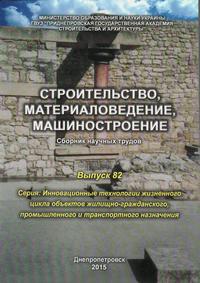Development of new algorithms for data processing for topological rationalization
Keywords:
topology optimization, sustainable design, SIMP method, technology of results filteringAbstract
Existing algorithms for processing the results of topological rationalization are imperfect. They can effectively treat the results only in the case of simple geometry, and for the evenly sized finite elements. They take a lot of time during the formation of the necessary matrices and inefficiently operate on large volumes of data. That is why the need to search for new and improved methods of processing the results of topological rationalization arises. Methodology. The proposed algorithm for processing the results of topological rationalization is based on the vectoring of coordinates of the centers elements and then on subsequent transfer of the basis of the coordinate system from one center of the element to another. To implement this idea, the program code in the MATLAB was developed. Results. This algorithm has been tested on the test problems of different size and of different geometrical complexity. The results confirm the effectiveness of the discussed method. A time saving on matrix formulation is observed to vary between factors of 2 and 6 depending on the size of the problem being solved. It is also found that along the increase of size of the problem the efficiency of the method also increases. Also the assumption about the possibility of a significant acceleration of the calculation of the topological rationalization has been confirmed. This was achieved by reducing the time spent on solution of finite element model through the implementation of iterative methods for solving systems of linear equations and usage of memory savings technology. Scientific novelty. Improvement in processing of the results of topological rationalization by applying data vectoring and memory preallocation. The practical significance. Usage of the proposed method can help to accelerate the introduction of topological methods for rationalization in everyday civil engineering design practice.References
K. D. Tsavdaridis, J. J. Kingman, and V. V. Toropov, “Structural topology optimisation in steel structural applications,” in Proceedings of the Hellenic National Conference of Steel Structures, 2014.
J. Kingman, K. Tsavdaridis, and V. Toropov, “Applications of topology optimisation in structural engineering: high-rise buildings & steel components,” Jordan Journal of Civil Engineering. 20-Nov-2014.
J. J. Kingman, K. D. Tsavdaridis, and V. V. Toropov, “Applications of topology optimisation in structural engineering: high-rise buildings & steel components,” Jordan J. Civ. Eng., vol. 9, 2014.
L. L. Stromberg, A. Beghini, W. F. Baker, and G. H. Paulino, “Application of layout and topology optimization using pattern gradation for the conceptual design of buildings,” Struct. Multidiscip. Optim., vol. 43, no. 2, pp. 165–180, Feb. 2011.
The MathWorks Inc., MATLAB and Statistics Toolbox Release 2012b. Natick, Massachusetts, United States., 2012.
M. P. Bendsoe and O. Sigmund, Topology Optimization: Theory, Methods and Applications. Springer Science & Business Medi, 2003.
E. Andreassen, A. Clausen, M. Schevenels, B. S. Lazarov, and O. Sigmund, “Efficient topology optimization in MATLAB using 88 lines of code,” Struct. Multidiscip. Optim., vol. 43, no. 1, pp. 1–16, 2011.
O. Sigmund, “A 99 line topology optimization code written in matlab,” Struct. Multidiscip. Optim., vol. 21, no. 2, pp. 120–127, 2001.
J. S. Jensen, “TOPOLOGY OPTIMIZATION THEORY , METHODS AND APPLICATIONS INTRODUCTION TO COMPUTER EXERCISES,” Delft, 2010.
G. H. Paulino, E. Silva, E. DE STURLER, S. WANG, C. C. SWAN, S. F. RAHMATALLA, C. TALISCHI, C. H. LE, and J. E. BAE, New Advances in Topology Optimization. Sao Paolo: Cornell University, 2008.
J. S. Jensen, “TOPOLOGY OPTIMIZATION THEORY, METHODS AND APPLICATIONS DESIGN IN VIBRATION AND WAVE PROPAGATION,” Delft, 2010.
Z. Jianhua, J. Shoushan, C. Yongdang, and W. Jilong, “Application of Variable Density Topological Optimization Method to the Design of High-Speed Ground Vehicle’s Chassis,” Int. J. Adv. Inf. Sci. Serv. Sci., vol. 4, no. 22, pp. 510–516, 2012.
ANSYS® Academic Research, Release 14.0, Help System,Performance Guide. ANSYS, Inc., 2014.
Downloads
Issue
Section
License
Редакція Видання категорично засуджує прояви плагіату в статтях та вживає всіх можливих заходів для його недопущення. Плагіат розглядається як форма порушення авторських прав і наукової етики.
При виявлені у статті більш ніж 25% запозиченого тексту без відповідних посилань та використання лапок, стаття кваліфікується як така, що містить плагіат. У цьому випадку стаття більше не розглядається редакцією, а автор отримує перше попередження.
Автори, в статтях яких повторно виявлено плагіат, не зможуть публікуватися в усіх журналах Видавництва ДВНЗ «Придніпровська державна академія будівництва та архітектури».
Автори, які публікуються у цьому журналі, погоджуються з наступними умовами:
- Автори залишають за собою право на авторство своєї роботи та передають журналу право першої публікації цієї роботи на умовах ліцензії Creative Commons Attribution License, котра дозволяє іншим особам вільно розповсюджувати опубліковану роботу з обов'язковим посиланням на авторів оригінальної роботи та першу публікацію роботи у цьому журналі.
- Автори мають право укладати самостійні додаткові угоди щодо неексклюзивного розповсюдження роботи у тому вигляді, в якому вона була опублікована цим журналом (наприклад, розміщувати роботу в електронному сховищі установи або публікувати у складі монографії), за умови збереження посилання на першу публікацію роботи у цьому журналі.
- Політика журналу дозволяє і заохочує розміщення авторами в мережі Інтернет (наприклад, у сховищах установ або на особистих веб-сайтах) рукопису роботи, як до подання цього рукопису до редакції, так і під час його редакційного опрацювання, оскільки це сприяє виникненню продуктивної наукової дискусії та позитивно позначається на оперативності та динаміці цитування опублікованої роботи (див. The Effect of Open Access).

